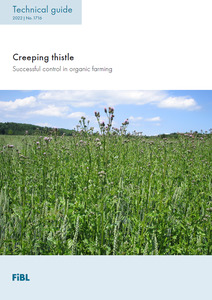{Tool} Creeping thistle - Successful control in organic farming. [Ackerkratzdistel - Im Biobetrieb dauerhaft regulieren.] Creator(s): Dierauer, Hansueli; Kranzler, Andreas and Ebert, Ulrich. Issuing Organisation(s): FiBL - Research Institute of Organic Agriculture. Technical guide. (2022)
|
PDF
- German/Deutsch
1MB | |
|
PDF
- Dutch/Nederlands
1MB | |
|
PDF
- Hungarian/Magyar
4MB | |
|
PDF
- Estonian/Eesti
1MB | |
![[thumbnail of 2022-07-13 16_15_41-.png]](/30989/54.hassmallThumbnailVersion/2022-07-13%2016_15_41-.png)  Preview |
Image (PNG)
- Cover Image
- English
850kB |
|
PDF
- Published Version
- English
7MB | |
|
PDF
- Published Version
- Romanian/Română
3MB | |
|
PDF
- Published Version
- Russian/Russkiy
3MB |
Document available online at: https://www.fibl.org/en/shop-en/1351-ackerkratzdistel.html
Summary in the original language of the document
In recent years, the creeping thistle has become a problematic weed, especially for organic arable farms with good soils.
Wherever it grows, it is competing with crops for water and nutrients. Once established, the thistle can only be reduced to a tolerable density with a lot of patience.
So far, there is no patent remedy for its control on organic farms. By abiding certain rules of plant cultivation in combination with direct methods, the thistle can be effectively controlled.
Summary translation
Die Ackerkratzdistel kann sich vor allem in Bioackerbaubetrieben mit guten Böden zu einem Problemunkraut entwickeln. Wo sie sich ausbreitet, konkurrenziert sie mit den Kulturen um Wasser und Nährstoffe. Einmal etabliert, lässt sie sich nur mit viel Geduld auf eine tolerierbare Bestandesdichte reduzieren.
Eine Patentlösung für die Bekämpfung der Ackerkratzdistel existiert bisher für den Biobetrieb nicht. Unter Beachtung gewisser pflanzenbaulicher Regeln und in Kombination mit direkten Methoden lässt sie sich jedoch dauerhaft und erfolgreich regulieren.
| EPrint Type: | Practice tool |
|---|---|
| Teaser: | Reduce creeping thistles by direct methods and good planning! |
| What problem does the tool address?: | The development of problematic weed in arable organic farming |
| What solution does the tool offer?: | This technical note provides an introduction to the creeping thistle growth characteristics and suggests various measures to control them. |
| Country: | Switzerland |
| Type of Practice Tool: | Leaflets & guidelines |
| Theme: | Weed management |
| Keywords: | arable farming, mechanical weed control, perennial weed, weed management |
| Keywords: | arable farming, mechanical weed control, perennial weed, weed management |
| Agrovoc keywords: | Language Value URI English arable farming http://aims.fao.org/aos/agrovoc/c_36528 English mechanical weed control http://aims.fao.org/aos/agrovoc/c_24200 English perennial weeds http://aims.fao.org/aos/agrovoc/c_5697 English weed control http://aims.fao.org/aos/agrovoc/c_8345 |
| Subjects: | Crop husbandry > Weed management |
| Research affiliation: | Switzerland > FiBL - Research Institute of Organic Agriculture Switzerland > Knowledge exchange > Advice European Union > Horizon 2020 > OK-Net Arable European Union > Organic Farm Knowledge European Union > Horizon 2020 > OK-Net Arable > selected tools |
| Related Links: | https://organic-farmknowledge.org/tool/30989, https://www.fibl.org/en/shop-en/1351-ackerkratzdistel.html |
| Project ID: | ofk |
| Deposited By: | Forschungsinstitut für biologischen Landbau, FiBL |
| ID Code: | 30989 |
| Deposited On: | 18 Jan 2017 11:57 |
| Last Modified: | 02 Apr 2025 08:42 |
| Document Language: | English, German/Deutsch, Dutch/Nederlands, Estonian/Eesti, Hungarian/Magyar |
| Status: | Published |
Repository Staff Only: item control page


